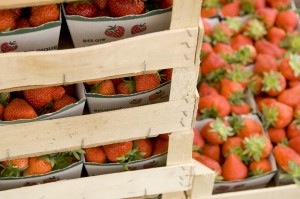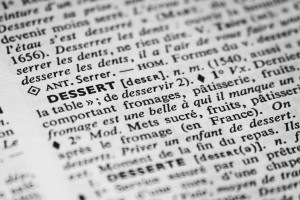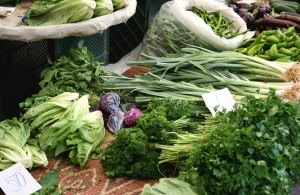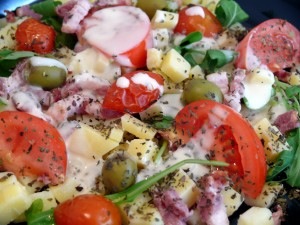How You Handle Food Really Matters
Here’s a great big reason why paying attention to how you handle food is so important:
Just give ‘em (bacteria) the conditions they like: warmth, moisture, and nutrients, and boy will they grow. A single bacterium that divides every half hour can result in 17 million offspring in 12 hours.
Putting food in the refrigerator or freezer will stop most bacteria from growing — except for Listeria (found in lunch meats, hot dogs, and unpasteurized soft cheese), and Yersinia enterocolitica (found in undercooked pork and unpasteurized milk). Both will grow at refrigerator temperatures. Cooking food to a temperature of 160 F will kill E. coli O157:H7. Don’t let that container of take out food hang around on the counter, either. Put it in the fridge and heat it up when you’re ready.
Safety Tips
- Cut produce, like half a watermelon or bagged salad, should be refrigerated or surrounded by ice – don’t buy it if its not
- Separate your raw meat, poultry, and seafood from the other food in your shopping cart and in your refrigerator – packages do leak
- Store perishable fresh fruit and vegetables (like berries, lettuce, herbs, and mushrooms) in a clean refrigerator at a temperature of 40F or below
- Wash your hands for 20 seconds with soap and warm water after you prepare any food
- Wash fruit and vegetables under running water just before eating, cutting, or cooking, even if you plan to peel them. Don’t use soap (it leaves a residue). Produce washes are okay, but not necessary.
- Scrub firm produce like melons and cucumbers with a clean produce brush and then let air dry.
- Toss the outer leaves of heads of leafy vegetables like cabbage and lettuce.
- Thoroughly cook sprouts. Children, elderly people, pregnant women, and people with a weakened immune system should avoid raw sprouts.
- Drink pasteurized milk, juice, or cider.
- Lower your pesticide exposure by 90% by avoiding the dirty dozen: peaches, apples, sweet bell peppers, celery, nectarines, strawberries, cherries, lettuce, imported grapes, carrots, and pears. Think about buying organic for the dirty dozen and conventional for the foods with the lowest levels of pesticides: onions, avocados, sweet corn, pineapple, mango, asparagus, sweet peas, kiwi, cabbage, eggplant, papaya, watermelon, broccoli, tomatoes, and sweet potatoes (Environmental Working Group).
- Eat locally grown food: food is well traveled – the average mouthful has a 1400 mile journey from farm to plate. Locally raised food is fresher, closer to ripe when picked, requires less energy to get to you, and is not as likely to be treated with pesticides after harvest.
- Wash all produce well before eating – be careful with nibbling the unwashed grapes or berries in the market or on the way home.




